Cognitive Psych Exam 1
1/99
There's no tags or description
Looks like no tags are added yet.
Name | Mastery | Learn | Test | Matching | Spaced |
|---|
No study sessions yet.
100 Terms
socrates/plato
epistemology (origins of knowledge)
plato compared knowledge to aviary/birds
aristotle
first psych book (de anima)
compared memory to a wax tablet, slowly cools to form an impression
explicit model of memory
empiricists
knowledge comes from experience
nativists
knowledge is a natural, genetic process
Donders
mental processes measured with mental chronometry
measured choice reaction time and simple reaction time with light flashes, subtraction method
simple rxn time: stimulus detection → response organization
choice rxn time: stimulus detection → identification → response organization
Helmholtz
unconscious inference (assume blue bar is one line under box)
Ebbinghaus
forgetting curve (not linear, lose information early on and then it evens out)
savings (how much easier it is to relearn something)
spacing effect (spreading out helps learning, not cramming)
Wundt
first psych laboratory
structuralism, introspection
structuralism
first school of psych
looks at ‘how does it operate’
trained people to describe their experiences (introspection)
limits of introspection
verification (can’t truly tell what they’re experiencing)
reliability (people report different info)
accessibility (some processes are automatic, can’t delve deep into it)
functionalism
next school of psych (William James)
looks at ‘why do we have it’
how are mental processes adaptive?
gestalt
next school of psych
the unified whole is different from the sum of its parts
we perceive the whole thing and interpret stimuli differently
ambiguous figures example
school of behaviorism
focused on stimulus and response, not mental processing
conditioned animals for entertainment
the limits of behaviorism → cognitive revolution
Skinner (behaviorism)
published Verbal Behavior
stated human language can be completely explained through imitation, reward, and lack of reinforcement
Chomsky (behaviorism)
criticized Skinner
introduced grammaticality judgement (can pick a grammatically correct sentence even if its nonsense)
cognitive maps / cognitive revolution
introduced by tolman
renewed interest in human factors engineering
new metaphors for information processing
new technologies allowed for new metaphors for human mind
*telecommunications → exchange of info through channels
*computers → input, processing, storage, output
generic information processing model (flow model)
inspired by computers
goal of studying the mind
understanding complex cognitive behaviors by:
*measuring observable behavior/physiology
*make inferences about underlying cognitive activity
structural model
looks at physiological elemtns (i.e. brain model, primate visual cortex)
process (flow) model
not structural, sequence of events
cognitive representations and processes must be inferred from…
behavior or physiology
behavioral approach
overt, deliberate responses from participants to infer their mental processes
physiological approach
physical repsonses that are not under conscious control
sensory neurons are …
afferent
motor neurons are …
efferent
activity of a neuron is indicated by …
rate of firing
specificity coding
each stimulus is a specific neuron
population coding
large collections of neurons associated with different concepts
pattern changes between specific objects
sparse coding
baseline firing for most neurons
select few fire for various stimuli
still uses patterns but less neurons
topographical organization
motor map in precentral gyrus
body parts close to each other are close together in brain
two paths for processing visual input
“where” pathway, dorsal pathway, parietal lobe
“what” pathway, ventral pathway, temporal lobe
brain regions and their functions
frontal lobe: cognitive functions, language, decision making
occipital lobe: vision
temporal lobe: auditory processing, memory, wernickes area (semantics)
parietal lobe: somatosensory strip, angular gyrus (language)
spatial resolution
precision and accuracy of location
temporal resolution
precision and accuracy of timing of the signals
physiological measures to measure brain activity
EEG, PET, fMRI, MEG, fNIRs (functional near infrared spectroscopy, light absorbed and sent back in banana shape)
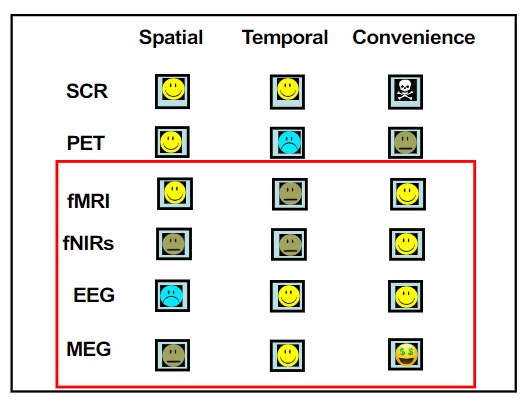
physiological measure used to influence behavior
TMS
distrubuted processing
various areas for location, distance, motion, color, shape, etc.
ex. looking at faces: gaze direction, attrativeness, emotional reaction, and face recognition (FFA)
langauge also distributed processing
neural networks
groups of neurons or structures that are connected together
technique: diffusion tensor imaging (DTI) and track weighted imaging
*shows structural connectivity
*maps that show this wiring called connectome
functional connectivity
parts of the brain involved in the same processes
use resting state fMRI to compare activity levels and synchronization of activity
major networks of the brain
somatosensory network
executive control network
salience network
dorsal attention network
visual network
default mode network (self awareness, episodic memories)
sensation
the experience of the raw environment from sensory organs
transduction
turning raw data into nerve impulses
attention
allocating resourcces to the processing
perception
organizing and interpreting info in the context of prior knowledge
challenges to perception
inverse projection problem (projection on retina looks same for different object, how do we determine what it is?)
incomplete data: blurred images, we piece together data
varying viewpoints
segmentation problem (separating words in speech, natural speech does not occur in convenient units)
how to overcome perception challenges
use knowledge and expectations (top down processing), such as unconscious inference and the likelihood principle
perceptual constancies/context effects (color and lightness constancy, top down overrides sensory info)
scene schema (expectations of an environment)
bayesian inference (estimation of probability of an outcome)
gestalt laws
transitional probabilities (statistical probability of a phoneme following another, separate words)
gestalt perceptual organization laws
pragnanz (simplest form)
figure and ground (distinguish boundaries to separate object from background)
proximity (objects close together are grouped together)
similarity (objects that look alike are grouped together)
continuation (line going in same path we see as continuous)
closure (complete images even with gaps)
common fate (objects that move together are grouped together)
physical regularities
physical properties of the environment
ex. horizontal/vertical, not diagonal (oblique effect)
light from above heuristic
color constancy (color is the same in different light)
lightness constancy (light & dark in brightness/shadows)
semantic regularities
objects in a place are predictable
scene schema: expectations of an enviornment
Biderman and Palmer experiements
bayesian inference
estimation of probability of an outcome
*prior (intial beleif about probability of an outcome)
*likelihood (consistency of evidence with outcome)
plasticity of neurons
fine tuned to specific stimuli
selective rearing (neurons more responsive to lines of environment grew up in)
experience dependent plasticity
facial processing depends on…
experience
other race effect
easier to distinguish adults of same race as you
other species effect
easier to identify/distinguish faces in same category
greebles
gauthier, different faces and genders, all had names participants memorized, FFA lights up
dissociations
tool used to identify brain areas involved in given functions
*single dissociation: brain area X injured can’t do A but can do B, A+B involved in different mechanisms, not necessarily independent
*double dissociation: brain area X injured, cant do A but can do B, another person with brain area X injured, cant do B but can do A, A+B are independent functions
brain ablation
ungerleider and mishkin
removed parts of brain
oreintation vs action (damage to temporal lobe)
embodied cognition
many processes are interconnected
attention
ability to focus on specific stimuli or locations
limited, finite resource
*selective attention: one stimulus, ignoring others
*divided attention: multitasking
models of selective attention
broadbent: filter model
treisman: attenuator model
mckay: late selection model
filter model of attention
messages →sensory store → physical property filter → detector → memory
early selection model, selected before it gets to meaning
emotional or personally relevant information can get through
following the meaning (dear aunt jane expeirment)
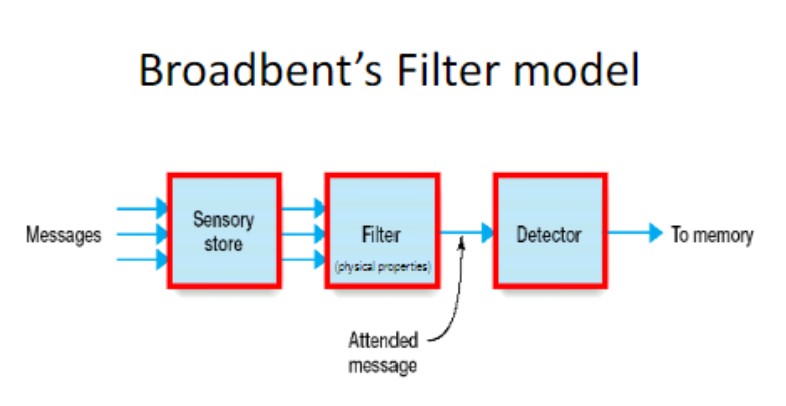
attenuator model of attention
messages → attenuator → dictionary unit → memory
early selection model
all messages analyzed by dictionary unit
some words have lower thresholds: common, emotionally salient, personal relevance
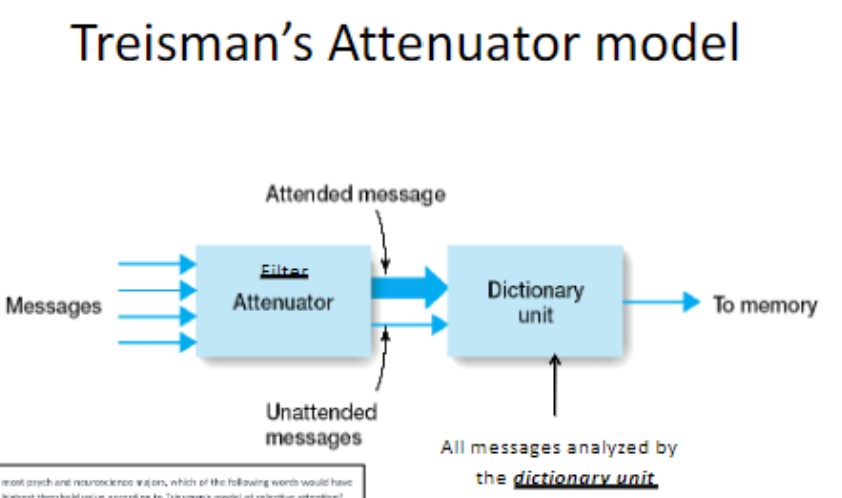
late selection model of attention
(mckay)
dichotic listening experiment: ambiguous sentences, biased words in unattended ear
processed beyond physical properties to meaning
more effort to process for recogntion and then select
when we select the message depends on …
cognitive resources (processing capacity, varies from person to person)
perceptual/cognitive load (task demands, how cognitively challenging is it?)
load theory of attention
perceptual load and distractions
resources used by tasks have to add up
endogenous attention
voluntary
top down
comes from you
exogenous attention
involuntary
something from the environment grabs attention
attentional capture: motion or sudden changes automatically draw our attention
overt attention
attentional shift accompanied by movement of eyes
covert attention
attentional shift not accompanied by eye movement
capacity/load theory
simultaneous tasks are possible unless the combination requires more capacity than available (mental effort)
capacity and allocation are affected by arousal, enduring dispositions (things that affect involuntary attention), and momentary intentions (goals)
attention is…
a limited resource
influenced by capacity and allocation
arousal, dispositions, intentions, and goals
how do you improve multitasking?
increase capacity (brain games)
make one task easier (more automatic, improve automaticity)
what interferes with automatic processing?
voluntary attention
choking
change blindness
difficulty in detecting obvious change in scenes presented consecutively
creating a visual disturbance (flicker paradigm, change contingent during saccade, blinking, mudsplatter, continuous action)
inattentional blindness
not seeing something in plain view (not attending to it)
attention is captured by the task (something obvious and perfectly visible is not noticed)
parsing the environment is done by…
location based attention
object based attention
location based attention
spotlight model, attention is limited resource so we shine the spotlight on something particular
supported by precueing studies
effect of visual cue changes with distance from target
object based attention
cue flashes then you find object
target that’s in the cued location = fastest
same object advantage (at incorrect locations, same object = faster)
overlapping objects: can attend to one object and ignore another at the same location
location based vs object based
depends on circumstances, how complex is the enviornment?
static/simple: location based
dynamic/difficult: object based
feature tntegration theory (fit)
binding problem
triesman: display of geometric objects, flanked by 2 black numbers, name objects then numbers
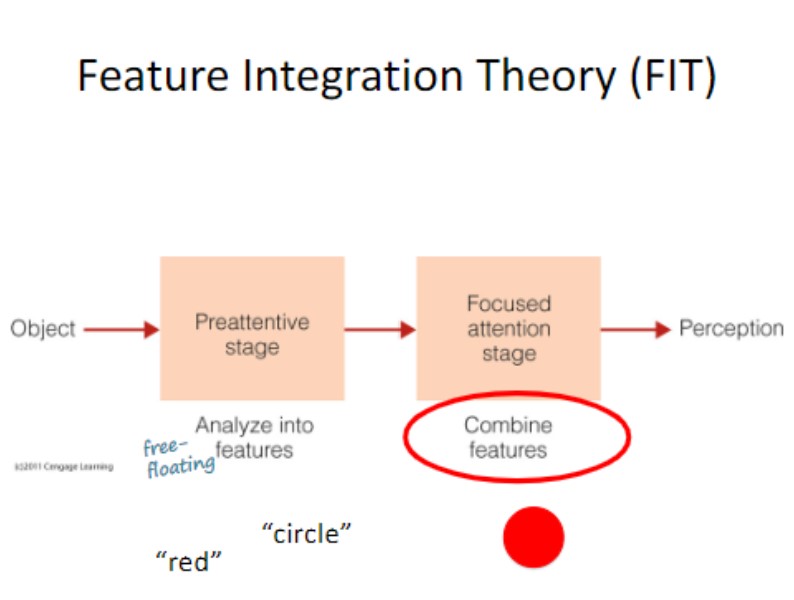
illusory conjunctions
balints syndrome
visual search
balints syndrome
damage to occipital/parietal lobe and occipital/temporal lobe
no integration wihtin scene (simultagnosia)
difficulty guiding eye movements (ocular apraxia)
visual search
feature search (red x in sea of green o’s)→ parallel processing
conjunction search (red x in sea of green x’s and red o’s)→ serial processing
datt & deyoe experiment
attention in the brain
shift attention from one part of the disc to another
brain activation changes
attentional network
dorsal stream, top down
ventral stream, stimulus salience, bottom up
synchronization of neurons firing → more effective communication
attentional warping
category representation distributed across the brain
attention influences “maps” of catgeories
modal model of memory
atkinson & shiffrin
size: sensory memory (huge), STM (4-9 items), LTM (infinite)
duration: sensory memory (brief), STM (few seconds), LTM (forever)
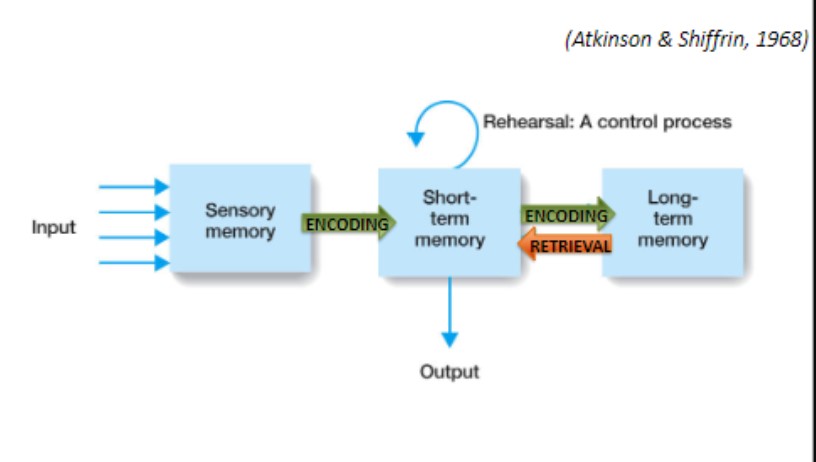
sensory memory (modal)
sperling’s studies - whole, partial, and delayed partial report
found partial report to be most effective
purpose of sensory memory:
*collect info for processing
*hold info during processing
*maintaining/filling in blanks during intermittent stimuli
STM (modal)
retention of information
serial position curve (start and end of list easier to remember, primacy effect (rehearsal) and recency effect)
digit span (5-9 numbers, George Miller)
Luck & Vogel measured STM for different complexities of objects (shape vs chinese character vs polygons)
chunking (combine stimuli into meaningful units)
baddeley’s argument against modal memory
STM is too simple
gave participants sentence and numbers to process
concluded that STM is storage + operations
working model of memory
baddeley
limited capacity “workspace”
*storage and control processing
central executive is in control
subsystems maintain auditory and visual/spatial information
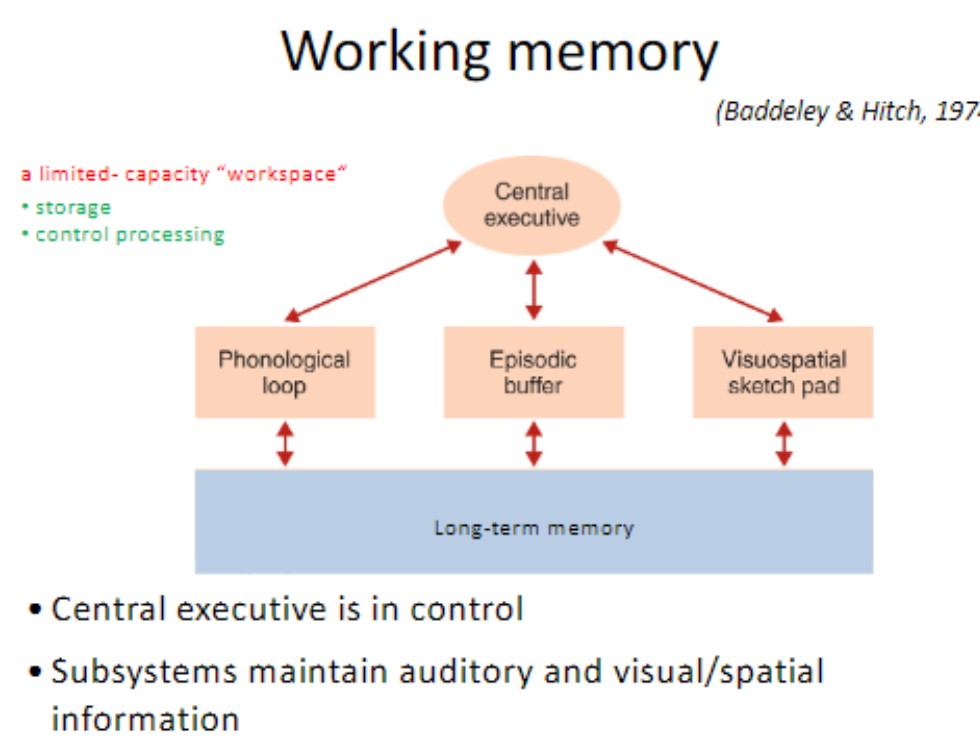
phonological loop (working)
holds verbal and auditory information
phonological store: holds info
articulatory rehearsal process: rehearsal
word length effect→ longer words take more time to pronounce, cant hold as many in memory
visuospatial sketchpad (working)
hold information on “what” and “where”
episodic buffer (working)
increases storage capacity
integrates information
facilitates communication with LTM
central executive (working)
inhibits unwanted, distracting stimuli
identifies relevant stimuli and allows for visual search
maintains goals
supervises and coordinates
switching tasks
splitting resources in divided attention tasks
getting info from LTM
OSPAN
measurement of working memory
measures the central executive
related to ability to control attention and ignore irrelevant information
*verify simple math problem, read word, repeat, recall words
correlates with measures of intelligence, and performance on many tasks
reading span
measurement of working memory
repeat last words of sentences
allocation of WM resources
controlled by central executive
easier to divide by subsystems
*sentence task: pointing Y/N easier than saying it
*corner task: saying Y/N easier than pointing to it
working memory in the brain
many areas implicated
PFC seems especially important
activity silent working memory
during retrieval, neurons activated more easily
change in connectivity = temporarily strengthened